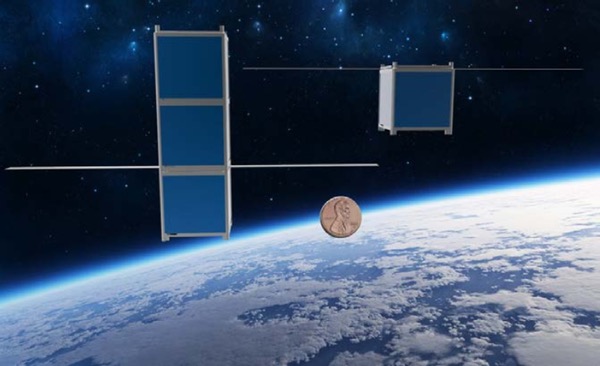When CubeSats are too bigby Jeff Foust
|
| “Our motivation for this work is to enable educators, universities, and high school and middle school students to actively participate in space exploration,” Thanga said. |
Part of that growing interest in CubeSats is because CubeSats themselves have grown. Introduced as cubes 10 centimeters on a side and weighing about one kilogram, spacecraft developers have turned these standalone cubes into larger spacecraft. Today, 3U CubeSats—three cubes combined to form a spacecraft about 30 by 10 by 10 centimeters—are commonplace, while other work on 6U, 12U, and even larger spacecraft.
That growth in CubeSat size has led some to conclude there’s room at the bottom for something even smaller than a 1U CubeSat. One new initiative started last month hopes to generate interest in a spacecraft design that’s a fraction of a size of a single CubeSat.
The SunCube concept, developed at Arizona State University and unveiled last month, is patterned on the CubeSat concept, but scaled down. A “1F” SunCube (the “F” comes from “femtosatellite,” a term sometimes applied to spacecraft smaller than a one-kilogram CubeSat) is three centimeters on a side, with a mass of 35 grams. A 3F SunCube, analogous to a 3U CubeSat, is three 1F cubes stacked together, measuring nine by three by three centimeters and weighing 100 grams.
Jekan Thanga, the Arizona State professor who led development of the SunCube concept, said he hopes the smaller, and thus less expensive, design will encourage more spacecraft development, particularly in schools. “Our motivation for this work is to enable educators, universities, and high school and middle school students to actively participate in space exploration,” he said at an April 7 presentation about SunCube on the Arizona State campus.
SunCubes, he added, could also support science and technology demonstrations. “The other motivation is to enable low-cost access to space for researchers to send proof-of-concept experiments,” he said. “You can develop low-cost, truly disposable spacecraft and robots where thousands can be sent.”
| “They’re not going to be a space hazard per se, because they’ll naturally degrade out of their orbits.” |
Miniaturization, the same advance that has benefited CubeSats, also makes the smaller SunCubes possible, Thanga argues. A 1F satellite has solar panels, a UHF radio capable of transmitting at a few kilobits per second, and a three-megapixel camera that can conduct low-resolution Earth imaging. “Everything about it should resemble the technologies in the CubeSat world, but a little bit more miniaturized, maybe a little bit more rudimentary,” he said.
The 3F version, he said, would free up more volume for additional payloads or enhanced capabilities. “You have now two-thirds of your volume to do whatever else you want,” he said, such as adding a second camera to do stereo imaging. “Compared to the 1F, this now seems like paradise.”
 Jekan Thanga holds a model of a 3F SunCube during a presentation about the satellite concept at Arizona State University April 7. (credit: J. Foust) |
Keeping the SunCube small, he argued, is key to lowering its costs and thus making it accessible to the educational community. Launching a single 1F satellite into low Earth orbit, such as from the ISS, would cost $1,000 to $3,000. Parts for that basic satellite could drop to less than $300 per satellite, assuming mass production. (That mass production isn’t available for some components yet: Thanga said his group had to hand-cut the solar panels since they were not readily available in such small sizes.)
SunCubes, he suggested, might work best in swarms, with many satellites working in conjunction in Earth orbit or on missions to other bodies in the solar system. A dispenser the size of a single 1U CubeSat could accommodate nine 3F SunCubes or 27 1F SunCubes.
There are, he acknowledged, issues with SunCubes, some technical and others more a matter of perception. The low data rate of individual satellites means sending even a single image time-consuming, making the spacecraft less valuable for research. Thanga suggested that multiple spacecraft could communicate in parallel, providing an enhanced data rate.
It might be possible, he added, to use S-band communications in place of UHF for those satellites, but said going beyond that, such as to X-band, was unlikely for the foreseeable future. Other ways to get around the communications bottleneck he offered was the use of inflatable or deployable antennas on the SunCubes, or, particularly for interplanetary missions, a “mother-daughter” configuration where a swarm of SunCubes communicates with a larger mothership that then transmits back to the Earth.
For spacecraft that remain in Earth orbit, there’s concern about their contribution to orbital debris. CubeSats have already been derided by some as “debris sats” given their proliferation and their small size that makes them difficult to track. Today, 1U CubeSats are at the edge of what can be reliably tracked, meaning that SunCubes may not be possible to track at all.
Thanga downplayed the orbital debris risk, arguing that, once deployed into low Earth orbit, they would remain there for only one to two years before reentering naturally, and this don’t pose a long-term debris risk. (He added that including a “little biscuit of tungsten” to the spacecraft could extend its life by about six months or so; the additional mass would reduce the effects of atmospheric drag.)
“We’re not going to be crowding up space,” he said. “They’re not going to be a space hazard per se, because they’ll naturally degrade out of their orbits.”
He acknowledged, though, that SunCubes will pose a tracking challenge while they are in orbit. “Tracking is a question,” he said when asked about it. One solution, similar to those proposed for CubeSats, would be to place some kind of beacon or other tool on the spacecraft itself to make it easier for tracking radars on the ground to find. “We haven’t looked into that yet, but we’re very eager to start that discussion.”
| “We wanted to meet a certain threshold of trying to get to the ISS for under or about $1,000.” |
There’s also the potential for competing standards. Thanga used last month’s event to release the initial draft of a design standards document, which discusses general design and testing requirements for SunCubes, and seek comments on it.
But the SunCube is not the only proposal for femtosat-class spacecraft. The PocketQube, introduced several years ago, is a cube five centimeters on a side, weighing about 180 grams. Several PocketQubes have flown already, deployed from another small satellite launched on a multimanifested Dnepr mission in 2013.
So why another femtosat standard? “What was driving that was costs,” he said about his choice of the three-centimeter form factor for SunCubes. “We wanted to meet a certain threshold of trying to get to the ISS for under or about $1,000.”
It’s not clear the SunCube standard, even more constraining than the PocketQube one, will take off: adoption of the PocketQube one has been slow so far. But as spacecraft technology advances, there are more opportunities for schools, organizations, and companies to experiment with what’s possible with inexpensive, very small spacecraft—much as they did with CubeSats a decade ago.
